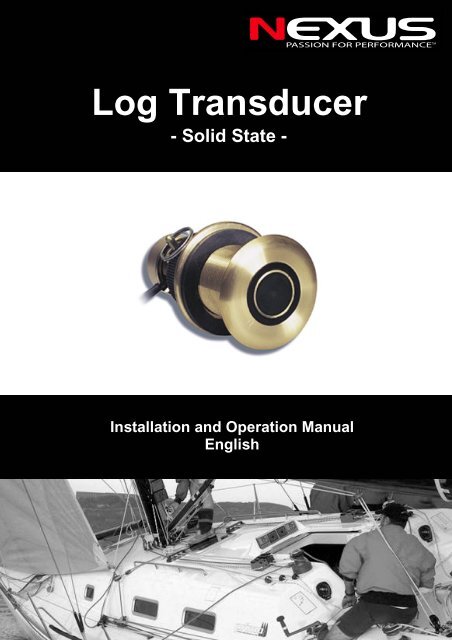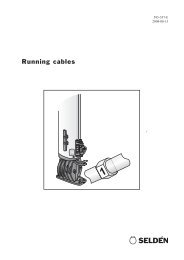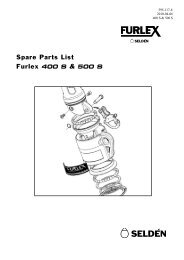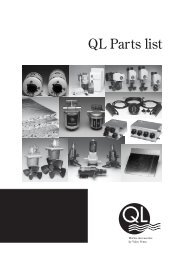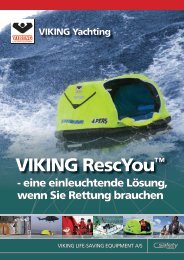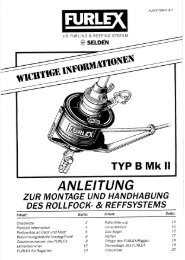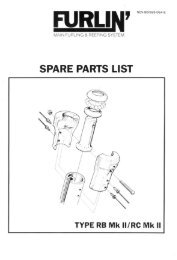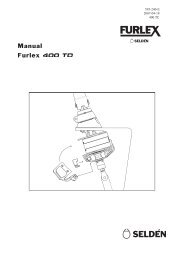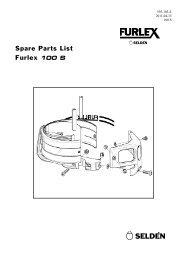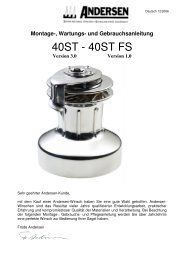Ultra Sonic Speed Transducer - Nexus Marine
Ultra Sonic Speed Transducer - Nexus Marine
Ultra Sonic Speed Transducer - Nexus Marine
You also want an ePaper? Increase the reach of your titles
YUMPU automatically turns print PDFs into web optimized ePapers that Google loves.
Log <strong>Transducer</strong><br />
- Solid State -<br />
Installation and Operation Manual<br />
English
OWNER’S GUIDE & INSTALLATION INSTRUCTIONS<br />
<strong>Ultra</strong>sonic <strong>Speed</strong> Sensor<br />
with Valve and Temperature<br />
Record the information found on the cable tag for future reference.<br />
Part No._________________Date___________Frequency________kHz<br />
69920-1 17-263-01 Ver 1.0 rev. 01 01-08 11/02<br />
Model CS4500-610<br />
U.S. Patents 5,186,050; 6,426,918<br />
IMPORTANT: Please read these instructions<br />
completely before proceeding with the installation.<br />
These instructions supersede any other instructions in<br />
your instrument manual if they differ.<br />
How the <strong>Ultra</strong>sonic <strong>Speed</strong> Sensor Works<br />
The speed sensor uses ultrasonic pulses to collect echoes from<br />
small particles in the water as they pass under two transducers<br />
embedded in the insert (see Figure 1). These transducers monitor<br />
the particles in their respective beams. As the boat travels through<br />
the water, both transducers “view” the same stream of particles.<br />
Because it takes time for particles to travel between the two<br />
transducers, the aft transducer detects the particles later than does<br />
the fore transducer. By measuring this time lapse, the instrument<br />
calculates the boat speed.<br />
The ultrasonic speed sensor requires particles in the water to<br />
obtain echoes. If the boat is airborne even for a short time or in<br />
highly aerated water, the sensor will measure an incorrect speed.<br />
IMPORTANT: The ultrasonic speed sensor must be in good contact<br />
with the water at all times for the sensor to function properly.<br />
CAUTION: NEVER USE SOLVENTS!<br />
Cleaners, fuel, paint, sealants, and other products may contain<br />
strong solvents, such as acetone, which can attack many plastics<br />
greatly reducing their strength.<br />
hull<br />
vessel direction<br />
particle stream<br />
scanning transducer<br />
FORE<br />
AFT<br />
Figure 1. Monitoring particles in the water<br />
Applications<br />
• Not recommended for boats designed to pull air under the hull.<br />
• Plastic housing recommended for fiberglass or metal hulls only.<br />
Never install a plastic sensor in a wood hull since swelling of the<br />
wood may overstress the plastic causing a fracture.<br />
• Bronze housing recommended for fiberglass or wood hulls only.<br />
Never install a bronze housing in a metal hull because electrolytic<br />
corrosion will occur.<br />
• Never install a metal housing in a vessel with a positive ground<br />
system.<br />
• <strong>Ultra</strong>sonic insert must be installed in a housing with a valve.<br />
Raymarine ST-40—The ultrasonic insert is too long for the<br />
existing housing. Install the new housing.<br />
Tools and Materials<br />
Water-based antifouling paint (mandatory in salt water)<br />
Safety goggles<br />
Dust mask<br />
Electric drill with 10mm or larger chuck capacity<br />
Drill bit 3mm or 1/8"<br />
Hole saw 51mm or 2"<br />
Sandpaper<br />
Mild household detergent or weak solvent (such as alcohol)<br />
File (installation in a metal hull)<br />
<strong>Marine</strong> sealant<br />
Additional washer [for aluminum hull less than 6mm (1/4") thick]<br />
Slip-joint pliers (installing a metal housing)<br />
Installation in a cored fiberglass hull (see page 3):<br />
Hole saw for hull interior 60mm or 2-3/8"<br />
Fiberglass cloth and resin<br />
or Cylinder, wax, tape, and casting epoxy
Antifouling Paint<br />
<strong>Marine</strong> growth can accumulate rapidly on the ultrasonic sensor’s<br />
surface reducing performance within weeks. Surfaces exposed to<br />
salt water must be coated with antifouling paint. Use water-based<br />
antifouling paint only. Never use ketone-based paint, since<br />
ketones can attack many plastics possibly damaging the sensor.<br />
It is easiest to apply antifouling paint before installing the sensor,<br />
but allow drying time. Reapply paint every 6 months or at the<br />
beginning of each boating season. Paint the following surfaces<br />
(see Figure 2):<br />
• Outside wall of the ultrasonic insert below lowest O-ring<br />
• Active face of the ultrasonic insert<br />
• Exterior lip of housing<br />
• Bore of housing up 30mm (1-1/4")<br />
• Blanking plug below lowest O-ring including exposed end<br />
Mounting Location<br />
ultrasonic<br />
insert<br />
housing<br />
& valve<br />
assembly<br />
Installation<br />
outside wall<br />
below<br />
lowest O-ring<br />
active face<br />
inside bore<br />
of housing<br />
up 30mm (1-1/4")<br />
exterior lip<br />
Figure 2. Antifouling paint<br />
Turbulence-free water must flow under the ultrasonic sensor at all<br />
speeds. Choose an accessible spot with a minimum of 200mm<br />
(8") of headroom inside the vessel to allow for the height of the<br />
housing, tightening the nuts, and removing the insert.<br />
• Fin keel sailboats—Mount the sensor on or close to the<br />
centerline and forward of the fin keel 150–300mm (1/2–1').<br />
• Full keel sailboats—Locate the sensor amidships and away<br />
from the keel at the point of minimum deadrise.<br />
• Displacement hull powerboats—Locate the sensor<br />
amidships near the centerline.<br />
• Planing hull powerboat—Mount the sensor well aft to ensure<br />
it will be in contact with the water at high speeds.<br />
Caution: Do not mount the sensor in an area of turbulence or<br />
bubbles: near water intake or discharge openings; behind strakes,<br />
fittings, or hull irregularities; or behind eroding paint (an indication<br />
of turbulence).<br />
Caution: Never mount the sensor directly ahead of a depth<br />
transducer, since turbulence generated by the housing will<br />
adversely affect the depth transducer’s performance, especially<br />
at high speeds.<br />
Cored fiberglass hull—Follow separate instructions on page 3.<br />
Hole Drilling<br />
Warning: Always wear safety goggles and a dust mask.<br />
1. Drill a 3mm or 1/8" pilot hole from inside the hull. If there is a rib,<br />
strut, or other hull irregularity near the selected mounting<br />
location, drill from the outside.<br />
2. Using the 51mm or 2" hole saw, cut the hole from outside the hull.<br />
3. Sand and clean the area around the hole, inside and outside, to<br />
ensure that the sealant will adhere properly to the hull. If there is<br />
any petroleum residue inside the hull, remove it with either mild<br />
household detergent or a weak solvent (alcohol) before sanding.<br />
Metal hull—Remove all burrs with a file and sandpaper.<br />
Bedding<br />
Apply a 2mm (1/16") thick layer of sealant around the lip of the<br />
housing that contacts the hull and up the sidewalls of the housing.<br />
The sealant must extend 6mm (1/4") higher than the combined<br />
thickness of the hull, washer(s), and hull nut (see Figure 3). This<br />
will ensure there is sealant in the threads to seal the hull and to<br />
hold the hull nut securely in place.<br />
P120 plastic housing<br />
ultrasonic insert<br />
cap nut<br />
safety wire<br />
hull nut<br />
B120 metal housing<br />
washer<br />
marine<br />
sealant<br />
hull<br />
marine<br />
sealant<br />
Figure 3. Bedding and installing<br />
2
Installing<br />
Caution: Never pull, carry, or hold the ultrasonic insert by<br />
the cable as this may sever internal connections.<br />
pour in<br />
casting<br />
epoxy<br />
9-12 mm<br />
(3/8-1/2")<br />
larger than the<br />
hole through the<br />
hull’s outer skin<br />
inner skin<br />
1. From outside the hull, push the housing into the mounting hole<br />
using a twisting motion to squeeze out excess sealant (see<br />
Figure 3). Align the arrow on the lip of the housing pointing<br />
forward toward the bow. If the sensor is not installed on the<br />
centerline, angle the housing slightly toward the centerline to<br />
align it with the water flow.<br />
2. From inside the hull, slide the washer onto the housing.<br />
Aluminum hull less than 6mm (1/4") thick—Use an<br />
additional rubber, fiberglass, or plastic washer. Never use<br />
bronze since electrolytic corrosion will occur. Never use wood,<br />
since it will swell possibly fracturing the plastic housing.<br />
3. Screw the hull nut in place being sure the notch on the upper rim<br />
of the housing and the corresponding arrow on the lip are still<br />
positioned forward toward the bow (see Figures 3 and 5). (If your<br />
plastic housing has wrenching flats, do not clamp tightly, possibly<br />
causing the housing to fracture.)<br />
Plastic hull nut—Hand-tighten only. Do not over-tighten.<br />
Metal hull nut—Tighten with slip-joint pliers.<br />
Wood hull—Allow the wood to swell before tightening the hull<br />
nut securely.<br />
4. Remove any excess sealant on the outside of the hull to ensure<br />
smooth water flow over the ultrasonic insert.<br />
Warning: The O-rings must be intact and well<br />
lubricated to make a watertight seal.<br />
5. After the sealant cures, inspect the O-rings on the ultrasonic<br />
insert (replace if necessary) and lubricate them with the silicone<br />
lubricant supplied.<br />
Important: For the sensor to work properly, the bottom of the<br />
insert must be flush with the bottom of the housing.<br />
6. Slide the ultrasonic insert into the housing with the arrow on the<br />
top pointing forward toward the bow. Seat it into place with a<br />
pushing twisting motion until the key fits into the notch. The arrow<br />
on the tip of the insert, the notch in the housing, and the arrow on<br />
the lip will be aligned. Be careful not to rotate the housing and<br />
disturb the sealant. Screw the cap nut in place and handtighten<br />
only. Do not over-tighten (see Figure 3).<br />
Warning: Always attach the safety wire to prevent the insert<br />
from backing out in the unlikely event that the cap nut fails or is<br />
screwed on incorrectly.<br />
7. Attach the safety wire.<br />
Plastic housing—Attach the safety wire to one eye in the hull<br />
nut. Lead the wire in a counterclockwise direction and thread it<br />
through one eye in the cap nut, along the side of the cap nut,<br />
through the second eye in the cap nut, and the second eye in<br />
the hull nut. Twist the wire securely to itself.<br />
Metal housing—Wrap one end of the safety wire tightly around<br />
the housing and twist it together with the long end. Lead the wire<br />
straight up and through the eye in the cap nut. Loop the wire<br />
back down and twist it securely to itself.<br />
8. To wire the ultrasonic sensor, follow the instructions, “Wiring” on<br />
page 5.<br />
hull thickness<br />
solid or hollow cylinder<br />
Figure 4. Preparing a cored fiberglass hull<br />
Checking for Leaks<br />
core<br />
outer skin<br />
Warning: Never install a thru-hull sensor and leave the boat in the<br />
water unchecked for several days.<br />
When the boat is placed in the water, immediately check around<br />
the thru-hull sensor for leaks. Note that very small leaks may not<br />
be readily observed. It is best not to leave the boat in the water for<br />
more than 3 hours before checking it again. If there is a small<br />
leak, there may be considerable bilge water accumulation after 24<br />
hours. If a leak is observed, repeat “Bedding” and “Installing”<br />
immediately.<br />
Installation in a Cored Fiberglass Hull<br />
The core (wood or foam) must be cut and sealed carefully. The<br />
core must be protected from water seepage and the hull must be<br />
reinforced to prevent it from crushing under the hull nut allowing<br />
the housing to become loose.<br />
Warning: Always wear safety goggles and a dust mask.<br />
1. Drill a 3mm or 1/8" pilot hole from inside the hull. If there is a rib,<br />
strut, or other hull irregularity near the selected mounting location,<br />
drill from the outside. (If the hole is drilled in the wrong location,<br />
drill a second hole in a better location. Apply masking tape to the<br />
outside of the hull over the incorrect hole and fill it with epoxy.)<br />
2. Using the 51mm or 2" hole saw, cut the hole from outside the<br />
hull through the outer skin only (see Figure 5).<br />
3. From inside the hull, use the 60mm or 2-3/8" hole saw to cut<br />
through the inner skin and most of the core. The core material<br />
can be very soft. Apply only light pressure to the hole saw after<br />
cutting through the inner skin to avoid accidentally cutting the<br />
outer skin.<br />
4. Remove the plug of core material so the inside of the outer skin<br />
and the inner core of the hull are fully exposed.Sand and clean<br />
the inner skin, core, and the outer skin around the hole.<br />
Caution: Completely seal the hull to prevent water seepage into<br />
the core.<br />
5. If you are skilled with fiberglass, saturate a layer of fiberglass cloth<br />
with a suitable resin and lay it inside the hole to seal and strengthen<br />
the core. Add layers until the hole is the correct diameter.<br />
Alternatively, a hollow or solid cylinder of the correct diameter<br />
can be coated with wax and taped in place. Fill the gap between<br />
the cylinder and hull with casting epoxy. After the epoxy has set,<br />
remove the cylinder.<br />
6. Sand and clean the area around the hole, inside and outside, to<br />
ensure that the sealant will adhere properly to the hull. If there is<br />
any petroleum residue inside the hull, remove it with either mild<br />
household detergent or a weak solvent (alcohol) before sanding.<br />
7. Proceed with “Bedding” and “Installing” on page 2.<br />
3
Operation, Maintenance, and Repair<br />
How the Valve Works<br />
The sensor incorporates a self-closing valve which minimizes the<br />
flow of water into the vessel when the ultrasonic insert is removed.<br />
The curved flap valve is activated by both a spring and water<br />
pressure. Water pushes the flap valve upward to block the<br />
opening, so there is no gush of water into the boat.<br />
WARNING: THE VALVE IS NOT A WATERTIGHT SEAL!<br />
Always install the ultrasonic insert or the blanking plug secured<br />
with the safety wire for a watertight seal.<br />
Using the Blanking Plug<br />
To protect the ultrasonic insert, use the blanking plug when:<br />
• The boat will be kept in salt water for more than a week.<br />
• The boat will be removed from the water.<br />
• Aquatic growth build-up is suspected due to inaccurate<br />
readings from the instrument.<br />
Warning: The O-rings must be intact and well<br />
lubricated to make a watertight seal.<br />
1. Inspect the O-rings (replace if necessary) and lubricate them<br />
with the silicone lubricant supplied or petroleum jelly (Vaseline®)<br />
(see Figure 5).<br />
2. Assemble the blanking plug. Place the cap nut on top of the<br />
plug and attach the pull ring to capture the cap nut.<br />
3. Remove the ultrasonic insert from the housing by removing the<br />
safety wire from the cap nut (see Figure 3).<br />
4. Unscrew the cap nut to jack the insert out of the housing. This<br />
will remove the cap nut and insert as a single unit.<br />
Warning: Always attach the safety wire to prevent the insert<br />
from backing out in the unlikely event that the cap nut fails or is<br />
screwed on incorrectly.<br />
5. Slide the blanking plug into the housing with the arrow pointing<br />
forward toward the bow (see Figure 5). Seat it into place with a<br />
twisting motion until the key fits into the notch. Screw the cap<br />
nut in place and hand-tighten only. Do not over-tighten.<br />
Reattach the safety wire (see Figure 3).<br />
Servicing the <strong>Ultra</strong>sonic Insert<br />
Caution: The active face of the ultrasonic insert is very fragile and<br />
easily damaged. Do not scratch, gouge, or sand it with coarse<br />
sandpaper.<br />
Aquatic growth will seriously affect the ultrasonic insert’s performance.<br />
Clean the active face with a dull putty knife being careful to avoid<br />
scratching the surface (see Figure 5). If fouling is severe, lightly wet<br />
sand the surface with fine grade (#320) wet/dry paper.<br />
O-rings must be free of abrasions and cuts to ensure a watertight<br />
seal. Install the large O-ring near the cap nut, the medium O-ring<br />
below it, and the small O-ring near the active face. The three<br />
remaining O-rings are placed in similar positions on the blanking<br />
plug (see Figure 5).<br />
Servicing the Valve Assembly<br />
Should the valve fail, remove it for servicing. A replacement O-ring<br />
and Valve Kit 33-450-01 is available.<br />
1. On the blanking plug, inspect (replace if necessary) and lubricate<br />
the O-rings with silicone lubricant or petroleum jelly (Vaseline®).<br />
4<br />
top view of<br />
ultrasonic<br />
insert<br />
ultrasonic<br />
insert<br />
valve<br />
assembly<br />
housing<br />
large O-ring<br />
medium O-ring<br />
small O-ring<br />
active face<br />
snap ring<br />
valve assembly with<br />
flap valve, spring,<br />
and retainer pin<br />
notch<br />
housing<br />
Figure 5. Servicing<br />
BOW •<br />
blanking<br />
plug<br />
2. Remove the ultrasonic insert from the housing (see Figure 3).<br />
3. Remove the snap ring from the valve assembly using a<br />
screwdriver to pry the end of the ring free (see Figure 5).<br />
4. Slide the valve assembly upward and out of the housing slowly.<br />
Note: The flap valve retainer pin is a loose slip-fit and may slide<br />
out when the assembly is removed.<br />
5. Slide the blanking plug (or ultrasonic insert) into the housing<br />
with the arrow on the top pointing forward toward the bow. Seat<br />
the plug into place with a twisting motion until the key fits into<br />
the notch. Screw the cap nut in place and hand-tighten only.<br />
Do not over-tighten. Reattach the safety wire (see Figure 3).<br />
6. Clean, repair, or replace the valve assembly so the flap valve<br />
moves freely and seats against the valve housing (see Figure 5).<br />
7. Remove the blanking plug. Slide the valve assembly into the<br />
housing with the flap valve pointing downward. Insert the snap ring<br />
being certain that it locks into the groove in the housing wall.<br />
Warning: Always attach the safety wire to prevent the insert<br />
from backing out in the unlikely event that the cap nut fails or is<br />
screwed on incorrectly.<br />
8. Slide the ultrasonic insert into the housing with the arrow on the<br />
top pointing forward toward the bow. Screw the cap nut until<br />
there is resistance.Seat the ultrasonic insert into place by<br />
rotating it until the key clicks into the notch. Continue to screw<br />
the cap nut into place hand-tightening only. Do not overtighten.<br />
Re-attach the safety wire (see Figure 3).
Wiring<br />
Tools and Materials<br />
Pencil<br />
Drill<br />
Drill bit: 3mm or 1/8"<br />
Cutting pliers<br />
Phillips screwdriver<br />
Wire strippers<br />
Electrical tape<br />
Blade screwdrivers<br />
Locating the Junction Box and Cable Routing<br />
Caution: Minimize electrical interference by separating the sensor<br />
cables from other electrical wiring and the engine.<br />
Caution: Be careful not to tear the cable jackets when passing<br />
them through the bulkhead(s) and other parts of the boat.<br />
1. Select a convenient, dry, mounting location for the waterproof<br />
junction box, about 1–2m (3' – 5') from the instrument (see<br />
Figure 6).<br />
2. Route the sensor cable to the proposed location of the junction<br />
box. Do not fasten the cable in place at this time.<br />
3. Hold the junction box at the selected location and mark the<br />
position of the four screw holes with a pencil.<br />
Note: If the junction box will be mounted on a vertical surface, face<br />
the compression bushings downward to avoid water seeping into<br />
the box.<br />
4. At the marked locations, drill a 3mm or 1/8" hole to a depth of<br />
10mm (3/8"). Do not screw the junction box in place at this time.<br />
5. Route the instrument cable to the junction box. Cut the cable<br />
50cm (2') beyond the junction box to allow for wiring ease.<br />
Do not fasten the cable in place at this time.<br />
6. Route the power cable from the battery to the junction box.<br />
Allowing 25cm (10") at each end for wiring ease, cut the cable<br />
to length. Do not fasten the cable in place at this time.<br />
BLK<br />
RED<br />
BATTERY<br />
screw hole (4)<br />
BRN<br />
WHT<br />
BARE<br />
GRN<br />
INSTRUMENT<br />
RED<br />
RED<br />
RED<br />
BLK<br />
GRN<br />
WHT<br />
SENSOR<br />
BRN<br />
grey<br />
wire with<br />
protective<br />
sleeving<br />
power panel<br />
(battery)<br />
Preparing the Cables<br />
SERVER<br />
instrument<br />
Figure 6. Cable layout<br />
sensor<br />
WARNING: The power must be “off” before proceeding.<br />
1. Remove the junction box cover (see Figure 7).<br />
2. Push approximately 200mm (8") of the power cable through the<br />
left compression bushing, being careful not to damage the<br />
circuit board.<br />
3. Push approximately 200mm (8") of the instrument cable<br />
through the center compression bushing, being careful not to<br />
damage the circuit board.<br />
4. Push approximately 200mm (8") of the sensor cable through<br />
the right compression bushing. Be careful not to damage the<br />
circuit board and the stripped wires.<br />
Note: The grey wire is covered with protective sleeving and this<br />
must remain in place.<br />
5. Strip 60mm (2-1/2") of the outer jacket and foil shielding from<br />
the cut ends of the power and instrument cables (see Figure 8).<br />
6. Strip 11mm (3/8") of conductor insulation from the end of each<br />
insulated wire in the power and instrument cables.<br />
7. Protect the cable’s foil shielding from causing a short inside the<br />
junction box. Wrap electrical tape around the jacket where the<br />
wires emerge from the cable. The tape must overlap the wires a<br />
minimum of 6mm (1/4").<br />
remove outer jacket<br />
60mm (2 1/2")<br />
remove<br />
insulation<br />
11mm<br />
(3/8")<br />
compression<br />
bushing (3)<br />
From Battery<br />
Use 2A Fuse<br />
From Server From Sensor<br />
Log input<br />
Figure 7. Junction box<br />
cable<br />
jacket<br />
electrical<br />
tape<br />
Figure 8. Preparing the cable—instrument cable shown<br />
5
Wiring the Junction Box<br />
1. From outside the junction box, carefully pull each of the cables<br />
in turn until only 13mm (1/2") of the cable jacket remains inside<br />
the box (see Figure 9).<br />
2. Starting with the battery cable, wire each cable in turn to the<br />
corresponding terminal block. Follow the color code on the PC<br />
board. Insert the stripped end of a wire in the hole in the<br />
corresponding terminal. Simultaneously depress the adjacent<br />
button using a small blade screwdriver. Release the button to<br />
lock the wire in place. Be sure the stripped end of the wire is<br />
inserted up to the insulation only. Do not include any insulation<br />
inside the terminal. Gently tug on the wire to ensure it is locked<br />
in place. Repeat this process until all wires are connected.<br />
Caution: Sensor cable—Do not attempt to connect the bare<br />
wire and grey wire. The bare wire has been cut off flush with the<br />
cable jacket, and the grey wire has been covered with protective<br />
sleeving. Do not allow these wires to short anything in the<br />
junction box.<br />
3. Hand-tighten the nut on each compression bushing to make a<br />
waterproof seal.<br />
4. Arrange the wires neatly inside the junction box being sure that<br />
no bare wires are touching.<br />
5. Attach the junction box cover with the screws provided for a<br />
waterproof seal.<br />
6. Using the screws provided, attach the junction box to the<br />
selected mounting surface at the holes previously drilled.<br />
Wiring the Instrument<br />
To connect the instrument cable to the display, follow the<br />
instructions in your instrument owner’s manual for connecting a<br />
speed sensor. See the color code below.<br />
Red B+ (5 to 15V)<br />
Green (GRN) signal<br />
Bare<br />
ground<br />
White (WHT) temperature<br />
Brown (BRN) temperature<br />
Wiring the Power Panel (Battery)<br />
<strong>Nexus</strong> Server<br />
Green<br />
Yellow<br />
Bare<br />
Wite<br />
Jumper from Bare<br />
Warning: The power panel must have a 1/2 amp fast blow fuse or<br />
breaker.<br />
Cut off the bare wire flush with the cable jacket. To connect the<br />
power cable to the power panel, see the color code below.<br />
Red +10 to 15 VDC<br />
Black (BLK) – VDC<br />
Troubleshooting<br />
No <strong>Speed</strong> Reading<br />
• Is the ultrasonic insert installed in the housing and connected to<br />
the junction box?<br />
• Is the ultrasonic insert oriented with the arrow on the top<br />
pointing forward toward the bow? If the insert cannot be seated<br />
in the housing with the arrow pointing forward, check that the<br />
arrow on the lip of the housing is pointing forward toward the<br />
bow. If this is not the case, the housing needs to be reinstalled<br />
with the proper orientation.<br />
• Is power being supplied to the junction box? The power must be<br />
10-15VDC. At lower voltages performance is degraded and the<br />
unit will shut down. If there is no voltage, check the wiring.<br />
AIRMAR<br />
TECHNOLOGY CORPORATION<br />
6<br />
button<br />
button<br />
BLK<br />
RED<br />
BATTERY<br />
BRN<br />
WHT<br />
BARE<br />
GRN<br />
INSTRUMENT<br />
RED<br />
RED<br />
BLK<br />
GRN<br />
WHT<br />
SENSOR<br />
• Are the wire connections at the terminals in the junction box<br />
tight and properly stripped of insulation?<br />
• Does the color of each wire match the color label on the PC<br />
board?<br />
Inaccurate <strong>Speed</strong> Readings<br />
• If the ultrasonic speed sensor is “on” when the boat is<br />
stationary, you may see a speed readout of a fraction of a knot<br />
because of water movement under the hull.<br />
• If the speed reading is consistently the same percentage higher<br />
or lower than the true speed, the speed function within the<br />
instrument needs to be recalibrated. Follow the instructions in<br />
your instrument owner’s manual.<br />
• If speed readings are inaccurate above about 10knots:<br />
- The sensor is installed in turbulent water. The cause may be<br />
water intake or discharge openings, strakes, fittings, hull<br />
irregularities upstream of the sensor, or the shape of the hull<br />
in that area. The sensor must be re-installed in another<br />
location.<br />
- The ultrasonic insert is covered with aquatic growth. See<br />
“Servicing the <strong>Ultra</strong>sonic Insert” on page 4.<br />
- Aerated water is flowing across the sensor because the boat<br />
is designed to pull air under the hull. The sensor will not work<br />
on this type of boat.<br />
Replacement Parts<br />
If you have purchased a plastic housing and have a wood hull or<br />
desire greater strength, purchase a bronze housing. Obtain the<br />
following parts from your marine dealer or instrument manufacturer.<br />
Blanking<br />
Plug<br />
20-600<br />
Figure 9. Wiring the Junction Box<br />
Cap Nut<br />
04-234-1 (plastic)<br />
02-131-01 (bronze)<br />
Hull Nut<br />
04-004 (plastic)<br />
02-030 (bronze)<br />
Sensor Replacement<br />
The information needed to order a replacement Airmar sensor is<br />
printed on the cable tag. Do not remove this tag. When ordering,<br />
specify the part number and date.<br />
BRN<br />
Housing, Washer<br />
& Hull Nut<br />
33-340-02 (plastic)<br />
33-340-01 (bronze)<br />
Copyright ©:<br />
35 Meadowbrook Drive, Milford, New <strong>Nexus</strong> Hampshire <strong>Marine</strong> 03055-4613, AB USA<br />
www.airmar.com<br />
Kuskvägen 4, 191 62 Sollentuna, Sweden<br />
Tel: +46 -(0) 8 – 506 939 00. Fax: +46 -(0) 8 -506 939 01<br />
www.nexusmarine.se<br />
O-ring &<br />
Valve Kit<br />
33-450-01
Copyright ©:<br />
<strong>Nexus</strong> <strong>Marine</strong> AB<br />
Kuskvägen 4, 191 62 Sollentuna, Sweden<br />
Tel: +46 -(0) 8 – 506 939 00. Fax: +46 -(0) 8 -506 939 01<br />
www.nexusmarine.se<br />
69920-1 Edition 1, For Solid State Log Tx


